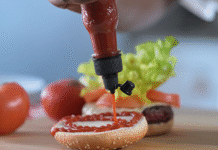The paper titled ‘Whisky tasting using a bimetallic nanoplasmonic tongue’ has recently been published in the Royal Society of Chemistry’s journal Nanoscale. The research was conducted by engineers and chemists from the Universities of Glasgow and Strathclyde was supported by funding from Leverhulme Trust, Engineering and Physical Sciences Research Council and Biotechnology and Biological Sciences Research Council.

Scottish engineers describe how they built the tiny taster, which exploits the optical properties of gold and aluminium to test tipples. An artificial ‘tongue’ which can taste subtle differences between drams of whisky could help cut down on the trade-in counterfeit alcohol, scientists say.
Sub-microscopic slices of the two metals, arranged in a checkerboard pattern, act as the ‘tastebuds’ in the team’s artificial tongue. The researchers poured samples of whisky over the tastebuds – which are about 500 times smaller than their human equivalents – and measured how they absorb light while submerged.
Statistical analysis of the very subtle differences in how the metals in the artificial tongue absorb light – what scientists call its plasmonic resonance – allowed the team to identify different types of whiskies. The team used the tongue to sample a selection of whiskies from Glenfiddich, Glen Marnoch and Laphroaig.
The tongue was able to taste differences between drinks with more than 99% accuracy. It was capable of picking up on the subtler distinctions between the same whisky aged in different barrels, and tell the difference between the same whisky aged for 12, 15 and 18 years, scientists say.
While describing about the artificial tongue and its capabilities, Alasdair Clark, paper’s lead author from the University of Glasgow’s School of Engineering, says, “We call this an artificial tongue because it acts similarly to a human tongue – like us, it can’t identify the individual chemicals which make coffee taste different from apple juice but it can easily tell the difference between these complex chemical mixtures.”
“We’re not the first researchers to make an artificial tongue, but we’re the first to make a single artificial tongue that uses two different types of nanoscale metal ‘tastebuds’, which provides more information about the ‘taste’ of each sample and allows a faster and more accurate response.”
He further adds, “While we’ve focused on whisky in this experiment, the artificial tongue could easily be used to ‘taste’ virtually any liquid, which means it could be used for a wide variety of applications. In addition to its obvious potential for use in identifying counterfeit alcohols, it could be used in food safety testing, quality control, security – any area where a portable, reusable method of tasting would be useful.”
IndiFoodBev — authentic, impactful and influential
An English-language food and beverage processing and packaging industry B2B platform in print and web, IndiFoodBev is in its third year of publication. It is said that the Indian food and beverage industries represent approximately US$ 900 billion in revenues which implies more than 20% of the country’s GDP. Eliminating the wastage on the farmside can help to deliver more protein to a higher number of the population apart from generating sizable exports. The savings in soil, seeds, water, fertilizer, energy and ultimately food and nutrition could be the most immense contribution that country is poised to make to the moderation of climate change.
To improve your marketing and grow sales to the food and beverage processing and packaging industry, talk to us. Our research and consulting company IppStar [www.ippstar.org] can assess your potential and addressable markets in light of the competition. We can discuss marketing, communication, and sales strategies for market entry and growth.
Suppliers and service providers with a strategy and budget for targeted marketing can discuss using our hybrid print, web, video, and social media channels to create brand recognition linked to market relevance. Our technical writers are ready to meet you and your customers for content.
The second largest producer of fruit and vegetables in the world is continuously expanding processing capacities and delivery systems with appropriate innovative technologies. We cover product and consumer trends, nutrition, processing, research, equipment and packaging from farm to thali. Get our 2025 media kit and recalibrate your role in this dynamic market. Enhance your visibility and relevance to existing markets and turn potential customers into conversations. Ask for a sample copy of our bi-monthly in print or our weekly IndiFoodBev eZine each Wednesday.
For editorial info@ippgroup.in — for advertisement ads1@ippgroup.in and for subscriptions subscription@ippgroup.in
Naresh Khanna – 10 February 2025
Subscribe Now











